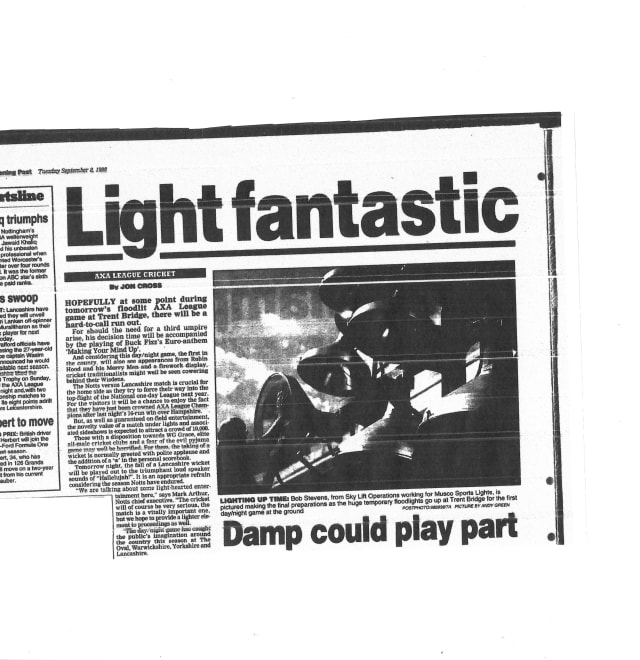Trent Bridge marks first floodlit game
There are few better sights – and sounds – than Trent Bridge on a T20 Blast night or when England’s white ball side is racking up record scores in the glow of the floodlights.
Such times are so much a part of cricket life now that it seems remarkable that day/night games are less than thirty years old.
In fact, it is just a quarter of a century since this famous old ground staged its first floodlit game, a 40-over Axa League match against Lancashire, played on 9 September 1998.
The lights used that night were not the impressive and effective permanent set that illuminate the cricket today but temporary, retractable, pylons hired in for the evening. Indeed, such was the weather that night the lights could not be extended to their full height.
Wind and rain not only meant that the lights were not fully extended but also that this pioneering match had to be reduced to 26 overs per side. In an example of how we were all learning about the limited-over floodlit game, the Outlaws then had to reduce their innings to just 24 overs as a penalty for a slow over rate when bowling.
To be fair, some of the time lost was spent fetching the ball as Lancs racked up what was for that era a challenging 221-2 (so close, Ritchie) from their 26 overs.
Peter Smith, a Heritage Volunteer at Trent Bridge was in the crowd that night and remembers it well. “We had to wait for the weather to ease up but we certainly got plenty of entertainment under the lights.
“My principal memory is of Freddie Flintoff, not yet the star he was to become but already in the England set-up, pinging three huge sixes, at least one of which went over the old Parr stand!”
Flintoff in fact scored 93no, at a very 21st Century strike rate of 169.09; his three sixes were matched by Mike Watkinson as they battered Notts for a 91-run partnership in just 10 overs.
The Outlaws never really got up to the required rate. Although Mat Dowman nearly matched Flintoff, making his 37 at 168.18, Notts fell well short, losing by 52 runs.
Despite the weather and the result, the evening was a great success and pretty much backed up the pre-match billing.
Many of the elements that are now firmly established as part of the day/night experience such as loud music and fireworks (plus an appearance from Robin Hood) were used for the first time that evening to welcome a side that had clinched the Axa League title the night before, to add to the NatWest Trophy they’d won four days earlier.
Nottinghamshire were hoping for a big crowd on this first, experimental, night with 2,000 tickets sold in advance and at least as many more expected through the gates on the night.
“The day/night game has caught the public’s imagination around the country this season”, said then chief executive Mark Arthur in the Nottingham Post’s preview, “…a lot of people, some new to cricket, will turn out. 
“If floodlit cricket is a way of bring more people into the game on a regular basis then it is obviously something we will have to look at doing again”, Arthur added – and he can hardly have known just how vibrant and vital the white-ball, floodlit, game would be in the next twenty-five years.
On the night, more than 4,000 fans attended and if many of them were, then, ‘new to cricket’ it is fair to assume that they are now among the regulars that throng to Trent Bridge on such nights.
Nottingham had a wider role in this first floodlit season of matches – local firm Musco Sports Lighting had the ECB contract to supply all the temporary lighting around the country, including those at Trent Bridge.
For a ground that has been staging cricket for more than 180 years, a twenty-five year span feels quite short but in terms of impact, few single events can have been quite so significant as a rain-soaked defeat to Lancashire under the (temporary) lights of September 1998.
September 2023